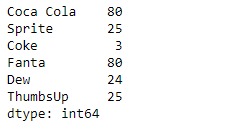Pandas 係列是帶有軸標簽的一維ndarray。標簽不必是唯一的,但必須是可哈希的類型。該對象同時支持基於整數和基於標簽的索引,並提供了許多方法來執行涉及索引的操作。
Pandas Series.factorize()函數將對象編碼為枚舉類型或分類變量。當所有重要的事情是識別不同的值時,此方法對於獲取數組的數字表示很有用。
用法: Series.factorize(sort=False, na_sentinel=-1)
參數:
sort:排序唯一性和隨機標簽以保持關係。
na_sentinel:標記“not found”的值。
返回:
labels:ndarray
uniques:ndarray,索引或分類
範例1:采用Series.factorize()函數編碼給定係列對象的基礎數據。
# importing pandas as pd
import pandas as pd
# Creating the Series
sr = pd.Series(['New York', 'Chicago', 'Toronto', None, 'Rio'])
# Create the Index
sr.index = ['City 1', 'City 2', 'City 3', 'City 4', 'City 5']
# set the index
sr.index = index_
# Print the series
print(sr)輸出:

現在我們將使用Series.factorize()函數編碼給定係列對象的基礎數據。
# encode the values
result = sr.factorize()
# Print the result
print(result)輸出:

正如我們在輸出中看到的,Series.factorize()函數已成功編碼給定係列對象的基礎數據。注意,缺少的值已分配為代碼-1。
範例2:采用Series.factorize()函數編碼給定係列對象的基礎數據。
# importing pandas as pd
import pandas as pd
# Creating the Series
sr = pd.Series([80, 25, 3, 80, 24, 25])
# Create the Index
index_ = ['Coca Cola', 'Sprite', 'Coke', 'Fanta', 'Dew', 'ThumbsUp']
# set the index
sr.index = index_
# Print the series
print(sr)輸出:

現在我們將使用Series.factorize()函數編碼給定係列對象的基礎數據。
# encode the values
result = sr.factorize()
# Print the result
print(result)輸出:

正如我們在輸出中看到的,Series.factorize()函數已成功編碼給定係列對象的基礎數據。
相關用法
- Python pandas.map()用法及代碼示例
- Python Pandas Timestamp.tz用法及代碼示例
- Python Pandas Series.str.contains()用法及代碼示例
- Python Pandas dataframe.std()用法及代碼示例
- Python Pandas Timestamp.dst用法及代碼示例
- Python Pandas dataframe.sem()用法及代碼示例
- Python Pandas DataFrame.ix[ ]用法及代碼示例
- Python Pandas.Categorical()用法及代碼示例
- Python Pandas.apply()用法及代碼示例
- Python Pandas TimedeltaIndex.contains用法及代碼示例
- Python Pandas Timestamp.now用法及代碼示例
- Python Pandas Series.str.pad()用法及代碼示例
- Python Pandas Series.take()用法及代碼示例
- Python Pandas dataframe.all()用法及代碼示例
- Python Pandas series.str.get()用法及代碼示例
注:本文由純淨天空篩選整理自Shubham__Ranjan大神的英文原創作品 Python | Pandas Series.factorize()。非經特殊聲明,原始代碼版權歸原作者所有,本譯文未經允許或授權,請勿轉載或複製。
